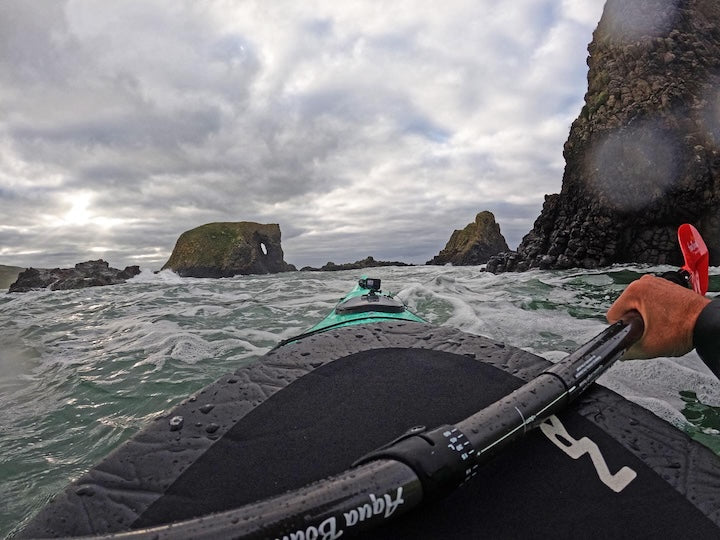Sea Kayaking Ireland’s Wild Atlantic Way
4-minute read + 2 videos
Lifelong kayaker (and Aqua Bound Ambassador) Ken Whiting and Paddle TV take us to the Republic of Ireland’s 1,600-mile-long Wild Atlantic Way for some adventurous sea kayaking and a taste of what The Emerald Isle has to offer.

(Photo courtesy of Paddle TV/Ken Whiting)
The third and fourth videos of Ken’s “Sea Kayaking Ireland” series give us a great look at this country’s gorgeous western coastline from sea and land. They also highlight some of the natural and historical treasures it has to offer.
Sea Kayaking around Castles
Before heading for his kayak, Ken explores Doolin Cave, just a 2-minute drive from the famous Cliffs of Moher. This natural wonder hosts the largest stalactite in Europe, known as the Great Stalactite, currently 23 feet long.
Patrick of North Clare Sea Kayaking is Ken’s guide in both videos. Ken says of him: “[Patrick] was born to be a sea kayak guide. He has a love for the marine environment, the ocean, the outdoors and everything that surrounds it. But on top of that, he just loves getting people on the water and sharing the experience and his backyard with people.”
To Ken’s delight, several castles are on the agenda for their kayak excursions. They’re visible from the water, but they enjoy taking the time to get on shore to explore these relics of the past on foot. They’re all located along the south shore of Galway Bay.
Ken looked forward to being able to kayak around castles in Ireland. “We don’t get to do that a lot in North America!” he said.
In this video you’ll see the ruins of:
- Shanmuckinish Castle is northeast of the city of Ballyvaughan. The castle was built in the 14th or 15th century. Its most prominent feature is its 5-story tower.
- Martello Towers were built during the Napoleonic Wars of the early 19th century. Built at the end of a long point, they were designed for strategic defense. Their cannons were never used though, as Napolean never invaded England or Ireland.
- Gleninagh Castle is a 16th-century structure with a well-preserved 4-story tower. It’s located along Galway Bay on the west side of Ballyvaughan.
Galway Bay is known for its stiff tidal current, sea life, castles and beauty. Patrick warns visitors not to expect sunshine and warmth—but it’s wonderful when they can get it! It’s not unusual to experience overcast skies and rain.
Wind and swell from the open sea can be an issue for sea kayakers on this western coast as they make their way into the Bay. Fortunately, these were minimal on the day of their planned tour and allowed for a memorable paddle.
Watch Sea Kayaking Ireland: Paddling Around Castles on the Wild Atlantic Way:
Sea Kayaking Inchiquin Lough near Burren National Park
Ken continues south along the 1,600-mile Wild Atlantic Way driving route from Galway Bay for his next kayak adventure. But first, he takes in a shoreline hike at the Bridges of Ross to see the dramatic cliffs and wave action there. Then taking the stairs up to the top of Loophead Lighthouse gives him a bird’s-eye view of the coast.
Due to rough seas in the Bay for their second day of kayaking, Ken and Patrick opted for some freshwater paddling instead. Patrick takes Ken on Inchiquin Lough on the border of lovely Burren National Park. This kayak tour is great for families, as even kids as young as six years old can come along.
At 365 acres, Inchiquin isn’t a large lough (lake), but Patrick has a special connection to it, as it’s very close to where he grew up. He learned to paddle on this beautiful lake that boasts a variety of ecosystems.
They explore marsh areas with plenty of birdlife, islands, agricultural shoreline and, of course, the ruins of a castle. “Any lake with a castle on it is a body of water worth exploring!” Ken said. Inchiquin Castle was first built in the 14th or 15th century.
Patrick explains the history of so many of these castle ruins. Many of them were abandoned in the 1820s and 30s because of high taxes. The owners would move to smaller and more modern homes and remove the roofs of the castles to avoid paying the high taxes. The weather and nature quickly moved in to take over, leaving these historic homes in ruins.
Their day on Inchiquin included kayaking up and back on the River Fergus, a quiet rural stream on Inchiquin’s northwest end.
Burren National Park offers unique beauty in County Clare. It’s named after the Irish boíreann, or rocky place, and is home to many species of flora that thrive in this treeless, seemingly inhospitable environment. The park lies between Inchiquin Lough and Ballyvaughan/Galway Bay.
Watch Sea Kayaking Ireland: Paddling Around Castles and River Kayaking in the Wild Atlantic:
See the first two videos in this series, Ken’s sea kayaking adventures in Northern Ireland.
What paddling questions can our friendly Customer Service team help you with? Contact us here: 715-755-3405 or sales@aquabound.com
More for you...





